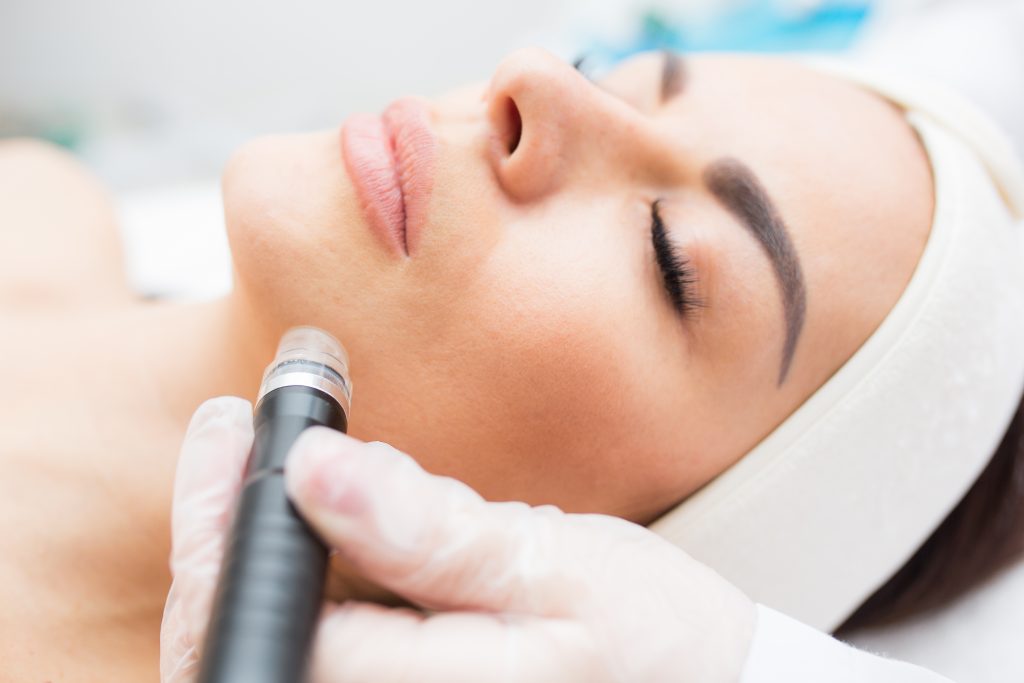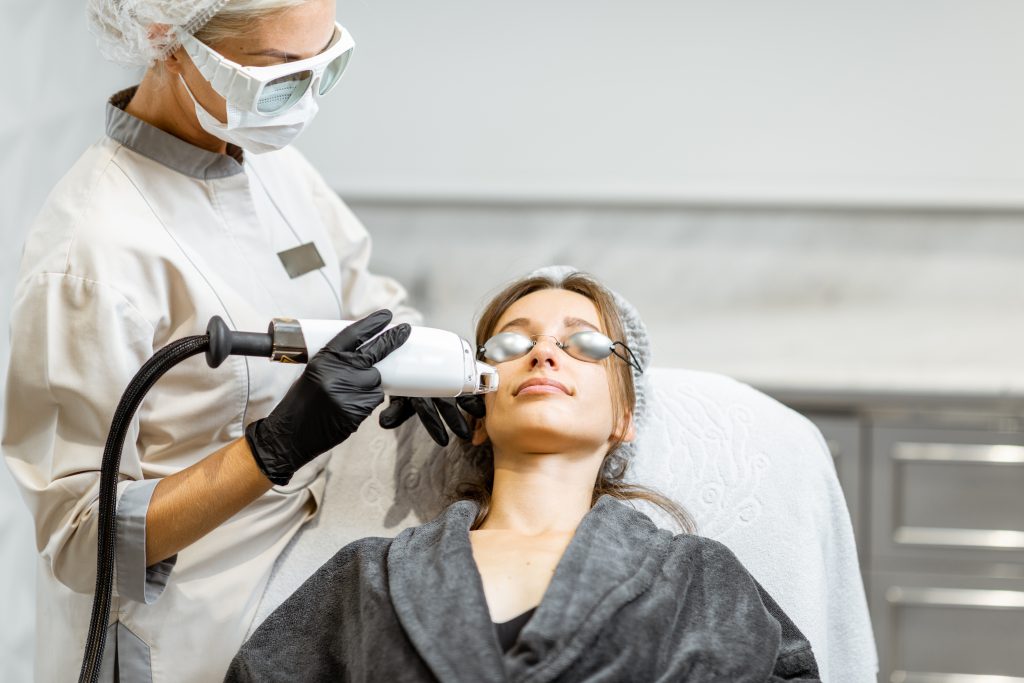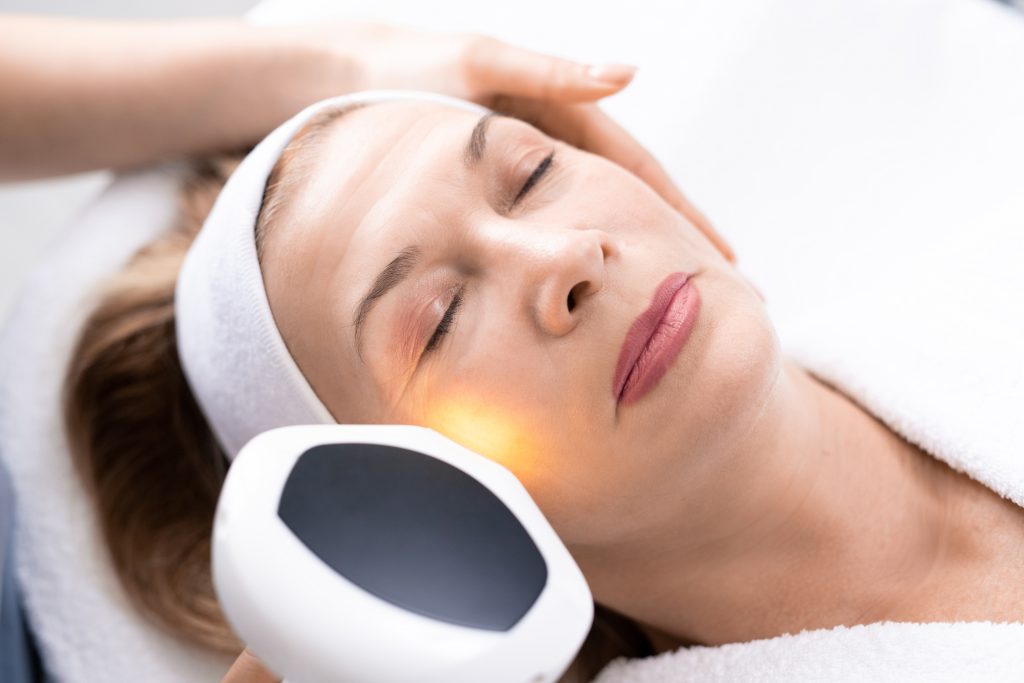Laser Skin Resurfacing
Laser skin resurfacing helps diminish wrinkles and scars, evens skin tone, tightens the skin, and eliminates lesions. It utilizes laser beams, which evaporate the top layers of your skin and stimulate the production of new collagen strands.

What laser skin resurfacing can improve?
- Non-responsive skin after a facelift
- Liver spots
- Small lines or creases appearing near or beneath your eyes, forehead, or mouth
- Scars from acne or chickenpox
- Warts
- If your skin tones appear yellowish or grayish, enhance your complexion.
- Birthmarks such as linear epidermal nevi
- Aged or sun-damaged skin
- Enlarged oil glands on the nose
When should I have laser skin resurfacing?
Are you aware that autumn is known as “laser season“? Due to the increased sensitivity of laser-treated skin to sunlight for approximately a year after certain procedures, cosmetic surgeons often advise getting laser resurfacing done during fall or winter. This is because the days are shorter and people tend to spend more time indoors during these seasons.
No matter when you undergo your laser procedure, it is important to apply a broad-spectrum sunscreen with SPF 30 or higher every day and reapply as necessary. Doing so not only maintains the quality of your results, but also offers defense against skin cancer and aids in avoiding further premature aging.
Who is a good candidate for laser skin resurfacing?
If you possess the following qualities, you might be a perfect fit for laser skin resurfacing:
- Scars from acne or chickenpox.
- Uneven skin pigmentation.
- Skin scars from birthmarks
- Sun-damaged skin
- Age spots, liver spots.
- Sun-damaged skin.
- Non-responsive skin after a facelift.
- Small lines or creases that are present near or beneath the eyes, on the forehead, or around the mouth
- Enlarged oil glands on your nose.

How does laser skin resurfacing work?
There are two types of laser resurfacing methods available. The first one involves the use of carbon dioxide (CO2) and erbium lasers, which cause a consistent injury to the skin in the treated area. The second method, known as fractionated CO2 laser treatment, drills multiple narrow holes in the deep layers of the skin using the laser, while leaving the surrounding skin untouched and undamaged.
CO2
The CO2 laser is a type of laser that uses Carbon Dioxide and provides four different treatment options. These treatments can range from minimizing the visibility of pores on the surface of your skin to effectively treating acne scars by penetrating deep into the dermis. Regardless of your specific concern, the CO2 laser is a valuable option, especially if you desire a thorough resurfacing treatment.
Erbium Laser Resurfacing
Erbium laser resurfacing is a procedure aimed at eliminating facial, hand, neck, or chest lines and wrinkles that are on the surface or moderately deep. One advantage of this method is that it minimally affects the surrounding tissue, resulting in fewer side effects like swelling, bruising, and redness. Consequently, the recovery period for erbium laser resurfacing is typically quicker compared to CO2 laser resurfacing. In certain instances, patients may recover within just one week. To determine the expected length of your recovery, consult your doctor.
Erbium laser resurfacing can be more effective for individuals with a darker skin tone. Nevertheless, there is a potential for skin discoloration following the procedure.
Fractional laser resurfacing
Since fractional CO2 laser resurfacing treats the skin with narrow columns of laser light, only a small portion of the skin is affected. The collagen in between the treated areas contracts, resulting in tighter skin. This type of laser treatment is advantageous because it causes less damage to the skin. However, there is a higher risk of complex healing and scarring due to the deeper penetration of the laser light compared to other lasers.
The recovery period after undergoing fractional laser resurfacing is seven days.
After thoroughly assessing your medical history, current physical state, and desired outcomes, your doctor will choose the most suitable laser resurfacing treatment for you.

What to expect from the procedure
Laser skin resurfacing aims at treating the top layer of your skin and at the same time warming the underlying dermis layers, resulting in increased production of collagen.
Ideally, the formation of fresh collagen fibers will result in the production of a new skin that has a smoother texture and feels more firm to the touch.
The process includes the subsequent actions:
- In order for laser skin resurfacing to be performed, your skin requires preparation. This entails receiving a number of treatments several weeks before the procedure. The objective is to enhance your skin’s ability to withstand professional treatments and reduce the likelihood of experiencing any negative effects.
- During the procedure, your doctor will administer a numbing medication to the specific area being treated. This is done in order to minimize any discomfort and enhance your comfort throughout the process. In cases where a significant portion of skin is involved, your doctor might recommend the use of sedatives or pain relievers.
- Afterward, the skin is thoroughly cleaned to eliminate any surplus oil, impurities, and bacteria.
- The treatment is initiated by your doctor, who employs the chosen laser to carefully move it around the specified section of your skin.
- Finally, the treatment area will be covered with wraps by your doctor in order to safeguard the skin after the procedure.
What results can I expect?
The outcome of laser resurfacing shows quick and ongoing changes. Shortly after the procedure, your skin will feel smoother and softer, appear brighter, and have a more balanced tone. Over the next 3 to 6 months, deeper layers of your skin will generate new collagen, leading to additional enhancements. Certain ablative laser treatments, though they may entail a lengthier recovery time, only necessitate a few sessions and can last for several years. On the other hand, non-ablative laser treatments may require multiple sessions to achieve optimal outcomes but involve less downtime.
What to expect from aftercare and recovery?
Even though certain dermatologic surgeons conduct laser resurfacing, these activities are not categorized as surgical procedures. After the treatment, you have the freedom to leave your doctor’s office right away.
However, it is essential to have periods of rest and recuperation to ensure that your skin heals correctly. This reduces the likelihood of experiencing any adverse effects and assists in attaining the desired outcome.
Treatment in Türkiye:
The medical staff of surgical teams, doctors, and consultants at REHABTÜRK can provide the best treatment options and free consultations, striving to stay up-to-date on the latest medical technologies and methods.

